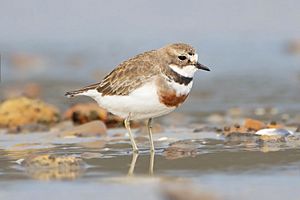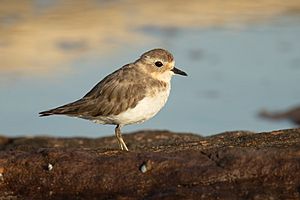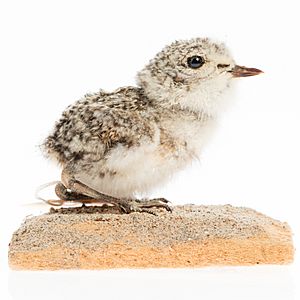Double-banded plover facts for kids
Quick facts for kids Double-banded plover |
|
|---|---|
 |
|
| Breeding plumage | |
 |
|
| Non-breeding plumage | |
| Conservation status | |
| Scientific classification | |
| Genus: |
Charadrius
|
| Species: |
bicinctus
|
The double-banded plover (Charadrius bicinctus) is a cool bird from the plover family. In New Zealand, people also call it the banded dotterel or pohowera. There are two main types, or subspecies, of this bird. One type, Charadrius bicinctus bicinctus, lives and breeds all over New Zealand, including the Chatham Islands. The other type, Charadrius bicinctus exilis, breeds in New Zealand's faraway subantarctic Auckland Islands.
Contents
About the Double-Banded Plover
What Does It Look Like?
The double-banded plover has a dark, grey-brown back. Its chest is white with two special bands. There's a thin black band just below its neck. Underneath that, there's a wider brown band. These bands look much brighter on male birds during breeding season. Young plovers don't have these bands. They are often speckled brown on top with less white.
These shorebirds have long legs. This helps them walk easily in shallow water and on sandy beaches. Their long, pointed wings help them fly long distances. They are very quick and agile in the air. The plover's head has large, dark-brown eyes and a strong black bill. It can be tricky to spot these birds because their colors blend in with their home. But you can often hear their "chirp-chirp" call. They also have a unique way of finding food. They run quickly, then stop to peck at food. This can help you spot them!
Where Do They Live?
Most double-banded plovers live in New Zealand. This is where they build their nests. However, some of them are migratory. This means they travel far away for winter. Some plovers that nest in the South Island of New Zealand fly to Australia, New Caledonia, Vanuatu, or Fiji. They also go to other warm, tropical countries. But every bird always comes back to New Zealand to breed and lay eggs.
You can find banded dotterels all over New Zealand. They are most common along the northern coasts and on nearby islands. There's also a large group on Stewart Island. Some birds on the Auckland and Chatham Islands only travel short distances. But those from the South Island often fly hundreds of kilometers to Australia. Birds that stay in New Zealand for winter usually move north. They go to coastal areas in the North Island.
Their Favorite Homes
Northern plovers often live on sandy beaches and sandpits. Some also like shell banks in harbours. A few even live on gravel beaches. They often build their nests near stream mouths. During breeding season, males make many nests. These nests are on open, slightly raised sand patches or on shells. Sometimes they are in cushion plants. The nests are usually padded with materials found nearby.
Plovers in southern New Zealand, like on Stewart Island, prefer to breed in open, stony areas high up in the mountains. But when it's not breeding season, they move to the coast. They feed along the beaches. Braided rivers are also a favorite home for many dotterels. You can find them in areas like Canterbury.
How They Live
Family Life and Breeding


Around July, banded dotterels start their breeding season in New Zealand. This happens mostly in the South Island and southern North Island. Places like Hawke's Bay, Marlborough, Kaikoura Peninsula, Canterbury, Otago, and Stewart Island are popular.
These birds form pairs for the breeding season. They stay with one partner to help raise their young. Before breeding starts, the male grows bright colored bands on his chest. Females are attracted by the male's loud calls. The male then shows her several nests he has built. The female chooses one. The male also protects his territory. He flies in fast, butterfly-like circles towards any bird that comes too close.
Nests are usually built on slightly raised, open spots on sand or shells. Sometimes they are in hollows in cushion plants or between rocks. The nests are well padded with things like grass, small stones, shells, lichen, moss, and twigs.
Many hundreds of birds can gather in one area during this season. From August to September, the dotterels lay two to four eggs. If something happens to the eggs, they can lay new ones up to three times. The eggs hatch in about 28–30 days. The young birds are ready to fly after about six weeks.
Banded dotterel chicks leave their nests on the same day they hatch. They follow their parents to find food. If there's any danger, the adult birds make an alarm call. The chicks quickly run a few feet and then squat down. They press their heads firmly against the ground. This helps them blend in with the sand and rocks. They stay perfectly still until their parents say it's safe to move.
Unlike most bird babies, these chicks feed themselves. Their parents stay close by to guard them for five to six weeks until they can fly. The parents then stay near for a few more days. After that, the chicks join other young birds and become fully independent. Many young birds return to their breeding grounds to mate when they are one year old. Others return in their second year.
What Do They Eat?
Double-banded plovers are mostly carnivores. This means they eat meat. They hunt for small water bugs and other insects along coastlines or rivers. They have also been seen eating berries from nearby shrubs like Coprosma and Muehlenbeckia.
These birds look for food both during the day and at night. They use different ways to hunt. During the day, plovers fly more often. They also spend more time standing still and watching for prey. They walk, peck, run, and groom themselves day and night. But they walk much more during the day. They spot insects moving and quickly run to peck them up.
At night, double-banded plovers peck repeatedly in one spot. They spend more time waiting in one area. This suggests they are trying to catch prey in their immediate surroundings. It's harder to see prey in the dark. By moving less, it's harder for prey to spot the plovers. This helps the plovers find their food more easily.
Plovers on breeding grounds eat a wider variety of foods. Their diet includes insect larvae, spiders, beetles, and water insects. These water insects include caddisflies, stoneflies, and mayflies. They also eat flies that live on land. Scientists have studied plover droppings. They found flies, adult beetles, and other bugs. Studies of New Zealand Dotterel birds in Canterbury riverbeds also showed they ate a lot of fruit from Coprosma petrei and Mueblenbeckia axillaris.
Dangers to Plovers
Since double-banded plovers nest on the ground, they face many dangers. New animals brought to New Zealand, like certain mammals, can be predators. Human activities can also destroy their homes. And some tiny creatures, called parasites, can harm them.
Predators
Hedgehogs are a big threat to banded dotterels. They are very hungry and eat the eggs and chicks of ground-nesting birds. Hedgehogs can travel up to two kilometers each night. This puts many plovers in danger.
Other mammals also threaten these birds. Dogs that are not controlled can run through nesting areas. This can crush eggs and disturb nesting birds. This is very harmful. Cats and stoats also hunt these ground-nesting birds and their young.
In one study, 41 nests were watched in New Zealand. Out of 16 nests that didn't hatch, eight were lost because of floods.
Parasites and Diseases
Tiny creatures called feather mites (Brephosceles constrictus) can also harm these birds. They mostly feed on the bird's blood, feathers, skin, or scales. This can take up to two hours. These mites can cause stress, lead to a lack of blood (anemia), and reduce egg laying. In some cases, they can even cause death.
Protecting the Plover
Before 1908, many banded dotterels in New Zealand were hunted. People shot them when they returned for breeding season. But in 1908, banded dotterels were put on a protected list. This stopped the hunting. Now, they are quite common.
In 2013, local Maori people in the Pencarrow Coast, Wellington region, placed a rahui on the area. A rahui is a temporary ban or restriction. This was done to protect about 20 pairs of banded dotterels from dogs and cars. In the Wellington region, this species is considered "Regionally Vulnerable." Overall, the species is classified as Near Threatened. This means they could become endangered in the future if we don't protect them.
Images for kids
Videos
See also
 In Spanish: Chorlitejo de dos bandas para niños
In Spanish: Chorlitejo de dos bandas para niños





